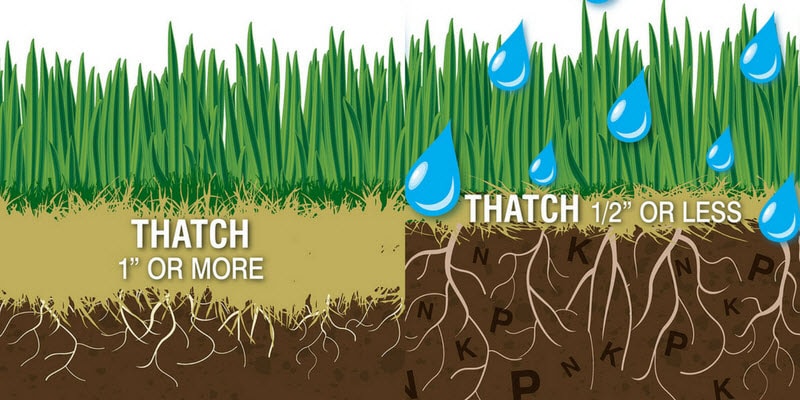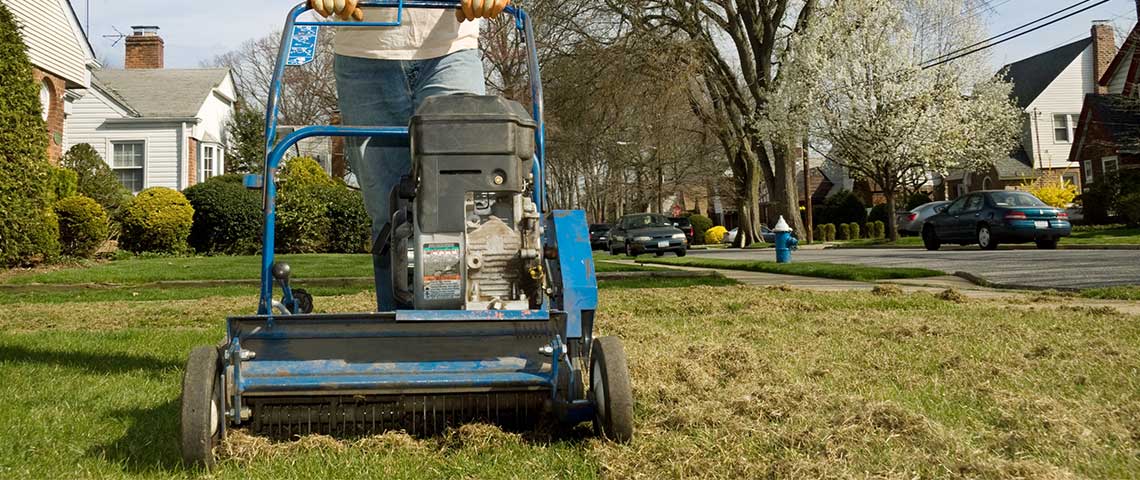Before dethatching, mow the lawn a little shorter than normal and preferably after a light rain or watering. These steps will help ensure better results during the dethatching process by enabling easier removal of thatch.
Additionally, applying water beforehand can help dilute any remaining fertilizer and ensure that the dethatching process does not interfere with the fertilizer’s effectiveness in promoting plant growth. Proper preparation before dethatching is crucial to achieving the best results for your lawn.
It involves mowing the lawn shorter than usual and considering the right timing for the process. In this guide, we’ll delve into the essential steps to take before dethatching, including the importance of mowing, the impact of soil moisture, and how to prepare the lawn for this necessary maintenance task. By understanding the pre-dethatching steps, you can ensure an effective and successful dethatching process for your lawn’s health and vitality.

Credit: m.youtube.com
Importance Of Proper Preparation
Proper preparation before dethatching is crucial. Mow slightly shorter, preferably after light watering, for optimal results. Aerating your lawn beforehand is also beneficial to ensure successful dethatching.
Mow Shorter Than Normal
Before dethatching, it’s important to mow your lawn a little shorter than normal. This allows for better access to the thatch layer and ensures more effective dethatching. Mowing shorter will also help to prevent the dethatching machine from getting clogged with tall grass, allowing it to work more efficiently. It’s recommended to set your mower at its lowest setting or adjust it to remove about a third of the grass height. Remember to only mow when the grass is dry to avoid clumping and uneven cutting.Timing Is Crucial
The timing of dethatching is crucial for its success. Ideally, you should dethatch your lawn when the grass is actively growing and able to recover quickly. Spring and fall are generally the best times to dethatch. In the spring, dethatching helps to remove any dead grass and debris accumulated during the winter months, while fall dethatching allows for better absorption of nutrients and enhances root growth before winter dormancy. Avoid dethatching during periods of extreme heat or drought, as it may stress out the grass.Preparation Is Key
Proper preparation is essential before dethatching your lawn. Here are a few key steps to take:- Water the lawn: It’s important to water the lawn thoroughly before dethatching. This will soften the soil and make it easier for the dethatching machine to remove the thatch layer.
- Clear the lawn surface: Remove any debris such as leaves, branches, and toys from the lawn. These can get entangled in the dethatching machine and hinder its effectiveness.
- Inspect for sprinkler heads and underground utilities: Before dethatching, carefully inspect the lawn for any sprinkler heads, underground utilities, or other obstacles that could be damaged by the dethatching machine. Mark them or flag them to avoid any accidents.
- Prepare the dethatching machine: Follow the manufacturer’s instructions to prepare the dethatching machine for use. This may involve adjusting the blade height or attaching any necessary accessories.

Credit: www.milorganite.com
Optimal Moisture Levels And Soil Conditions
Before dethatching your lawn, it is crucial to ensure that the moisture levels and soil conditions are optimal for the process. The amount of moisture in the soil can significantly impact the effectiveness of dethatching and the overall health of your lawn. Here are some essential considerations for preparing the soil and achieving the ideal moisture levels before dethatching:
Watering Before Dethatching
Proper watering is essential before dethatching your lawn. It helps to soften the soil and make it easier for the dethatching equipment to penetrate the thatch layer effectively. Ensuring adequate moisture in the soil before dethatching can prevent damage to the grass and promote a successful dethatching process.
Ideal Dryness Vs. Wetness
It’s crucial to find the right balance between dryness and wetness of the soil before dethatching. Avoid dethatching when the soil is overly wet, as it can lead to damage by pulling the grass out by the roots. On the other hand, excessively dry soil can make it difficult to remove the thatch effectively. Finding the optimal moisture level is key to achieving successful dethatching results.
Tools And Equipment Readiness
Before dethatching your lawn, it’s crucial to ensure that you have all the necessary tools and equipment ready. Proper tools and equipment readiness can significantly impact the success of your dethatching process. Let’s delve into the important aspects of tools and equipment preparation.
To-dos Before Preparing The Equipment
Before jumping into the dethatching process, certain tasks must be accomplished to ensure a smooth operation. It’s essential to pay attention to these preparatory steps to guarantee the effectiveness of the dethatching process.
The Right Tools For Dethatching
Choosing the right tools for dethatching is crucial for achieving optimal results. It’s essential to have the appropriate equipment on hand to ensure a successful dethatching endeavor. Here are some essential tools and equipment you may need:
| Tools and Equipment | Description |
|---|---|
| Dethatching Rake | A rake designed specifically for removing thatch and promoting a healthier lawn. |
| Lawn Dethatcher | A mechanical dethatching machine that efficiently removes thatch from the lawn’s surface. |
| Lawn Sweeper | An apparatus designed to collect and remove debris, thatch, and other lawn waste. |
| Power Rake | An electric or gas-powered rake suitable for dethatching larger lawn areas. |
Pre-dethatching Maintenance
Prior to initiating the dethatching process, it’s important to take care of certain maintenance tasks to ensure that the equipment is in proper working condition. Here are some crucial maintenance steps to consider:
- Inspecting the Dethatching Tools: Ensure that the dethatching tools are clean, in good repair, and functioning effectively.
- Checking the Engine: If utilizing a powered dethatching machine, inspect the engine and ensure that it’s in optimal working condition.
- Sharpening Blades: If using a dethatching rake or power rake, ensure that the blades are sharp and capable of efficiently removing thatch.
- Testing Equipment: It’s advisable to perform a test run of the dethatching equipment to ensure proper functionality before the actual dethatching process.
Avoiding Common Mistakes
Dethatching your lawn is an essential step in maintaining a healthy and vibrant yard. However, if not done correctly, it can cause more harm than good. To ensure a successful dethatching process, it’s important to avoid common mistakes. Let’s explore two crucial aspects to consider before dethatching: mowing height and preventing damage to the grass.
Mowing Height Pre-dethatching
Before dethatching, it’s advisable to mow your lawn a little shorter than usual. By doing so, you create an ideal environment for effective dethatching. Mowing shorter allows the dethatching machine or tool to penetrate deeper into the thatch layer, removing it more efficiently. However, it’s important not to go too short, as this can stress the grass and make it more susceptible to damage. Aim to remove around one-third of the grass’s height, ensuring you don’t exceed this threshold.
Preventing Damage To Grass
While dethatching is an essential process, it’s crucial to take measures to prevent damage to your grass. One way to do this is by avoiding dethatching when the soil is excessively wet or dry. When the soil is too wet, the dethatching equipment can pull the grass out by the roots, causing irreparable damage. On the other hand, dethatching during times of drought or when the soil is very dry can leave your grass parched and further stressed.
Another step you can take to prevent grass damage is to ensure your lawn is adequately watered before dethatching. Applying water before dethatching helps dilute any remaining fertilizer in the soil, preventing the dethatching equipment from damaging the granules or picking them up during the process. This way, the fertilizers can continue promoting healthy plant growth after dethatching.
By following these guidelines, you can avoid common mistakes and ensure a successful dethatching process. Remember to mow at the right height and choose the appropriate time to dethatch, keeping your grass healthy and beautiful.
Additional Considerations
Before dethatching, it’s crucial to consider a few essential points:
Dethatching Vs. Aerating:
Dethatching and aerating serve different purposes. While dethatching removes the layer of dead grass, aerating pulls plugs from the soil to improve air and water circulation.
Overseeding After Dethatching:
After dethatching, consider overseeding your lawn. This process helps fill in bare spots and promotes overall lawn health.

Credit: www.pennington.com
Frequently Asked Questions For What To Do Before Dethatching
How Do You Prep Before Dethatching?
To prep before dethatching, mow the lawn slightly shorter than normal and do it after a light rain or watering. Water the lawn before dethatching to dilute remaining fertilizer. Avoid dethatching when the soil is too wet or dry. Mow the lawn to half its normal height before dethatching.
Should I Cut My Lawn Short Before Dethatching?
Mow a little shorter than usual before dethatching. For better results, do it after light rain or watering.
Should I Water My Lawn Before Dethatching?
Before dethatching, mow the lawn shorter, and water lightly to prepare the soil. This helps the dethatching process and prevents damage to the grass.
Conclusion
Before dethatching your lawn, it is important to take certain steps to ensure the best results. Mowing your lawn a little shorter than normal and choosing to dethatch after a light rain or watering can improve the effectiveness of the process.
Additionally, watering your lawn before dethatching helps dilute any remaining fertilizer in the soil, preventing it from being disturbed during the dethatching process. It is also recommended to avoid dethatching when the soil is overly wet or dry, as this can damage the grass.
By following these guidelines, you can prepare your lawn for successful dethatching and promote healthy, vibrant growth.